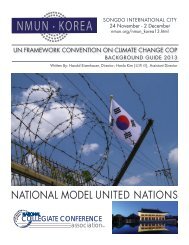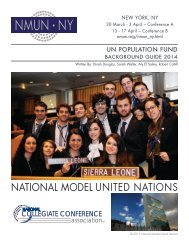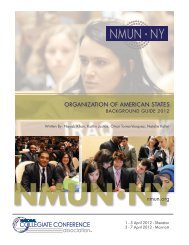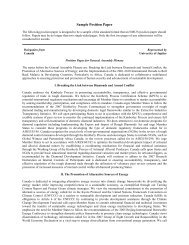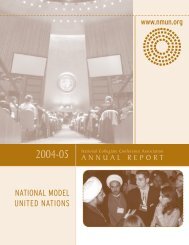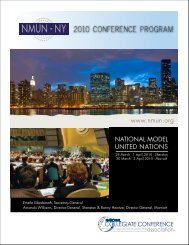UNCTAD Background Guide - National Model United Nations
UNCTAD Background Guide - National Model United Nations
UNCTAD Background Guide - National Model United Nations
You also want an ePaper? Increase the reach of your titles
YUMPU automatically turns print PDFs into web optimized ePapers that Google loves.
Chile’s success can also be attributed to its fiscal policy toward budget surpluses and deficits, enshrined in the 2006<br />
Fiscal Responsibility Bill. 178 The bill created target budget surpluses (relying on resource revenues) first set at 1 %<br />
of gross domestic product (GDP) and later reduced to zero in 2009 after copper prices collapsed. 179 Deficit targets<br />
could only be raised if output fell bellow potential (as in a recession) or if copper prices fell below 10-year<br />
averages. 180 To negate arbitrary changes in the target for political reasons, two expert panels biannually review<br />
production output and copper prices. 181 To demonstrate the separation of politics from the process, during the price<br />
boom from 2003-2008, politicians argued that increased copper prices where a permanent fixture and advocated<br />
increased government spending. 182 The expert panels correctly believed that the price spikes were only temporary<br />
and ruled that revenues be saved rather than spent. Following that policy, Chile paid down debts to 4 % of GDP,<br />
saved 12 % of GDP in the ESSF, and ran a 9 % surplus prior to recession in 2008 and 2009. 183<br />
International Involvement<br />
Despite widespread reliance on commodity exports, the international system remains largely devoid of agreement or<br />
codification on managing revenues from resource extraction. 184 Commodity markets have suffered three violent<br />
swings in recent decades. With each swing, states have emerged slightly more prepared for the next market event,<br />
yet many experts argue that an international agreement or code could serve as a guidance document to ensure that<br />
the same mistakes and failed policies are not repeated. 185 Renowned economist Paul Collier points to four important<br />
decision points regarding resource extraction that an international code could assist states in making: 1) negotiating<br />
the resource extraction contract, 2) design features of the contract, 3) transparency in revenues, 4) the aggregate<br />
savings decision, and 5) the public investment decision. 186<br />
There are however, three notable exceptions to the void in international agreement—the Extractive Industries<br />
Transparency Initiative (EITI), the Common Fund for Commodities (CFC), and the Natural Resource Charter. EITI<br />
is a multi-stakeholder voluntary program that publishes revenue information from extraction industries. 187 By<br />
publishing what companies pay and what governments receive through resource contracts and royalties, EITI aims<br />
to strengthen good governance through transparency and accountability. 188 To support broader implementation of<br />
the initiative, the World Bank’s Oil, Gas, and Mining Group manages the multi-donor trust fund (MDFT) that<br />
provides technical and financial assistance for states implementing EITI. 189 Members of EITI include 35 states (14<br />
EITI Compliant and 21 EITI Candidate status); 60 of the largest oil, gas, and mining companies; and over 80 global<br />
investment firms. 190 Additionally, EITI is supported by over 300 non-governmental organizations, the World Bank,<br />
International Monetary Fund, regional development banks, and is endorsed by the <strong>United</strong> <strong>Nations</strong>, G8, G20, African<br />
Union, European Union, and numerous other states and intergovernmental organizations. 191 The CFC, which was<br />
established under the auspices of <strong>UNCTAD</strong> in1980, enjoys similarly broad support, with 105 Member States and ten<br />
institutional members party to its mission to enhance social and economic development in CDDCs. 192 The CFC<br />
provides technical assistance and project financing to members and works to strengthen the trading position of<br />
LDCs. 193 Perhaps most relevant to the discussion of the international community’s role in harnessing resource<br />
extraction is the Natural Resources Charter. The Natural Resources Charter is a set of twelve precepts for<br />
governments and societies on harnessing the gains from resource extraction for development. 194 Composed by a<br />
178 Frankel, The Natural Resource Curse: A Survey, 2010, p. 29.<br />
179 Frankel, The Natural Resource Curse: A Survey, 2010, p. 29.<br />
180 Frankel, The Natural Resource Curse: A Survey, 2010, p. 29-30.<br />
181 Frankel, The Natural Resource Curse: A Survey, 2010, p. 29-30.<br />
182 Frankel, The Natural Resource Curse: A Survey, 2010, p. 30.<br />
183 Frankel, The Natural Resource Curse: A Survey, 2010, p. 30.<br />
184 Collier, Laws and Codes for the ‘Resource Curse’, 2007, p. 2.<br />
185 Collier, Laws and Codes for the ‘Resource Curse’, 2007, p. 2.<br />
186 Collier, Laws and Codes for the ‘Resource Curse’, 2007, pp. 5-11.<br />
187 Extractive Industries Transparency Initiative, Factsheet, p. 1.<br />
188 Extractive Industries Transparency Initiative, Factsheet, p. 1.<br />
189 The World Bank, About the EITI Multi-Donor Trust Fund, 2011.<br />
190 Extractive Industries Transparency Initiative, Factsheet, p. 4.<br />
191 Extractive Industries Transparency Initiative, Factsheet, p. 4.<br />
192 Common Fund for Commodities, CFC Project Financing.<br />
193 Common Fund for Commodities, The Future Role and Mandate of the Fund.<br />
194 Natural Resources Charter, Natural Resources Charter, 2010.



